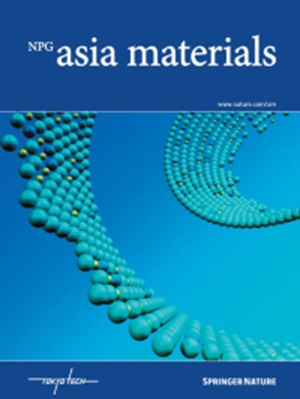瓦兹利-罗斯相 TiNb2O7 中网络拓扑结构与负电极特性之间的关系
IF 8.3
2区 材料科学
Q1 MATERIALS SCIENCE, MULTIDISCIPLINARY
引用次数: 0
摘要
Wadsley-Roth相TiNb2O7是由TiO6和NbO6组成的八面体网络,由于其优异的安全性和高的放电容量,近年来作为锂离子电池负极材料备受关注。在这项工作中,我们研究了被认为形成Li+传导通路的网络结构(中程结构)对TiNb2O7电极性能的影响。为此,我们制备了具有不同充放电特性的TiNb2O7样品,并生成了同时再现总散射和Bragg剖面数据的原子构型。基于持续同源性的拓扑分析表明,隐藏在平均结构(晶体结构)中的网络无序性显著降低了负极的性能。综上所述,控制网络拓扑结构是改善TiNb2O7负极性能的关键。近年来,由于越来越多地使用可再生能源,对更安全、更高效的可充电电池的需求不断增长。传统的锂离子电池存在安全风险,比如起火,尤其是在快速充电时。研究人员正在探索提高电池安全性和性能的新材料。他们研究了一种叫做TiNb2O7的材料,它可能是一种更安全的电池电极替代品。研究人员使用不同的方法制备了TiNb2O7,并测试了其在电池中的性能。他们使用先进的技术在原子水平上分析了这种材料的结构。这项研究的重点是原子的排列如何影响电池储存和释放能量的能力。结果表明,TiNb2O7具有良好的容量和安全性,具有作为电池电极的潜力。该研究得出结论,了解原子结构可以指导更好的电池材料的开发。本摘要最初是使用人工智能起草的,然后由作者进行修改和事实核查。在这项工作中,我们重点研究了Wadsley-Roth相具有八面体网络的TiNb2O7作为锂离子电池的负极材料,并研究了网络结构对电极性能的影响,该网络结构被认为是形成Li+传导途径的。为此,我们制备了具有不同充放电特性的样品,并生成了同时再现总散射和布拉格剖面数据的原子构型。基于持续同源性的拓扑分析表明,网络紊乱显著降低了电极的性能。本文章由计算机程序翻译,如有差异,请以英文原文为准。

Relationship between network topology and negative electrode properties in Wadsley–Roth phase TiNb2O7
Wadsley–Roth phase TiNb2O7, with an octahedral network consisting of TiO6 and NbO6, has attracted significant attention as a negative electrode material for lithium-ion batteries in recent years owing to its excellent safety and high discharge capacity. In this work, we investigated the effect of the network structure (intermediate-range structure), which is considered to form Li+ conduction pathways, on the electrode properties of TiNb2O7. To this end, we prepared TiNb2O7 samples with different charge/discharge properties and generated atomic configurations that simultaneously reproduce both total scattering and Bragg profile data. Topological analyses based on persistent homology demonstrated that the network disorder hidden in the average structure (crystal structure) significantly degrades the negative electrode properties. In conclusion, controlling the network topology is considered the key to improving the negative electrode properties of TiNb2O7. In recent years, the need for safer and more efficient rechargeable batteries has grown due to the increasing use of renewable energy. Traditional lithium-ion batteries have safety risks, such as catching fire, especially when charged quickly. Researchers are exploring new materials to improve battery safety and performance. They studied a material called TiNb2O7, which could be a safer alternative for battery electrodes. Researchers prepared TiNb2O7 using different methods and tested its performance in batteries. They used advanced techniques to analyze the material’s structure at the atomic level. This study focused on how the arrangement of atoms affects the battery’s ability to store and release energy. The results showed TiNb2O7 has potential as a battery electrode, offering good capacity and safety. The study concluded that understanding the atomic structure can guide the development of better battery materials. This summary was initially drafted using artificial intelligence, then revised and fact-checked by the author. In this work, we focused on Wadsley–Roth phase TiNb2O7 with an octahedral network as a negative electrode material for lithium-ion batteries and investigated the effect of the network structure, which is considered to form Li+ conduction pathways, on the electrode properties. To this end, we prepared samples with different charge/discharge properties and generated atomic configurations that simultaneously reproduce both total scattering and Bragg profile data. Topological analyses based on persistent homology demonstrated that the network disorder significantly degrades the electrode properties.
求助全文
通过发布文献求助,成功后即可免费获取论文全文。
去求助
来源期刊

Npg Asia Materials
MATERIALS SCIENCE, MULTIDISCIPLINARY-
CiteScore
15.40
自引率
1.00%
发文量
87
审稿时长
2 months
期刊介绍:
NPG Asia Materials is an open access, international journal that publishes peer-reviewed review and primary research articles in the field of materials sciences. The journal has a global outlook and reach, with a base in the Asia-Pacific region to reflect the significant and growing output of materials research from this area. The target audience for NPG Asia Materials is scientists and researchers involved in materials research, covering a wide range of disciplines including physical and chemical sciences, biotechnology, and nanotechnology. The journal particularly welcomes high-quality articles from rapidly advancing areas that bridge the gap between materials science and engineering, as well as the classical disciplines of physics, chemistry, and biology. NPG Asia Materials is abstracted/indexed in Journal Citation Reports/Science Edition Web of Knowledge, Google Scholar, Chemical Abstract Services, Scopus, Ulrichsweb (ProQuest), and Scirus.
 求助内容:
求助内容: 应助结果提醒方式:
应助结果提醒方式:


